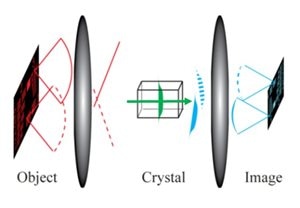May 24 2019
Scientists have formulated a unique high-resolution imaging technique that can capture mid-infrared spectral images of dynamic processes or fast events that occur on the order of milliseconds. This spectral range is used for a number of applications as it can reveal a sample’s complete chemical composition.
 Researchers developed a new system that uses frequency conversion to shift an entire mid-IR image into the near-infrared wavelength range while preserving the spatial information. The system can be used to look for the chemical specific signatures of cancer and other diseases. (Image credit: Peter Tidemand-Lichtenberg, DTU Fotonik)
Researchers developed a new system that uses frequency conversion to shift an entire mid-IR image into the near-infrared wavelength range while preserving the spatial information. The system can be used to look for the chemical specific signatures of cancer and other diseases. (Image credit: Peter Tidemand-Lichtenberg, DTU Fotonik)
“This novel approach could one day be used to prescreen medical biopsies to identify the ones that need closer examination,” said Peter Tidemand-Lichtenberg, a member of the research team from DTU Fotonik in Denmark. “It could be used to look for the chemical signatures of cancer and other diseases in ways that would increase the accuracy and speed of diagnoses.”
A multi-institutional group of scientists illustrate the new imaging method in Optica, The Optical Society's (OSA) journal for high-impact research. They also show some of the method’s possible applications by imaging a gas flow and differentiating cancerous and normal samples of esophageal tissue.
Although mid-infrared spectroscopy is recognized as a powerful tool for chemical analysis, its applicability has been hampered by a lack of affordable light sources and sensitive detectors. To overcome this barrier, we used an approach that translates information from the mid-infrared region, where the chemical signatures are most distinct, to the near-infrared, where today’s camera technology is most mature and sensitive.
Peter Tidemand-Lichtenberg, Study Member, DTU Fotonik
Practical mid-infrared spectroscopy
The scientists drew on a process called nonlinear frequency conversion wherein energy is added to a photon to alter its wavelength, and hence its color. Although frequency conversion, or upconversion, is frequently used to alter the wavelength of a laser’s output, the team from DTU Fotonik created a detection system that could shift a whole mid-IR image into the near-infrared wavelength range while keeping all the spatial information.
The system integrates a new mid-infrared light source designed by collaborators from The Institute of Photonic Sciences (ICFO). This single-wavelength light source can be adjusted to different wavelengths and it also uses frequency conversion to produce the mid-infrared light. In fact, the scientists used the same pulsed near-infrared laser for two purposes: to make the tunable mid-IR light and to realize the image upconversion.
This approach yields high peak power pulses in perfect synchronism, eliminating the need for sophisticated temporal control of the pulses, leading to images with a good signal-to-noise ratio. In addition, our optical setup is designed in a way that requires very little post-processing after the images are acquired.
Peter Tidemand-Lichtenberg, Study Member, DTU Fotonik
Imaging fast events and complex samples
The scientists showed the imaging speed of their new mid-infrared upconversion spectroscopy method by tweaking the illumination laser to match the peak absorption of a gas flow and obtaining a video with 40 images per second.
They also carried out a pilot study, headed by the researchers from Exeter University, in which the system was employed to assess cancerous and healthy esophageal tissue samples. They learned that morphology and spectral classification using their system corresponded well with the typical stained histopathology images.
Our upconversion imaging approach is generic and constitutes a major simplification in realizing video-frame-rate, mid-infrared monochromatic imaging. The spectral information provided by this technique could be combined with machine learning to enable faster, and possibly more objective, medical diagnostics based on chemical signatures without the need for staining.
Peter Tidemand-Lichtenberg, Study Member, DTU Fotonik
The research project was sponsored by the European Commission’s Innovative Training Networks and involved a collaborative team of scientists from The Institute of Photonics Sciences (ICFO) in Spain and DTU Fotonik as well as Exeter University and Gloucestershire Hospitals NHS Foundation Trust, both from the United Kingdom.